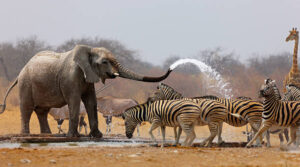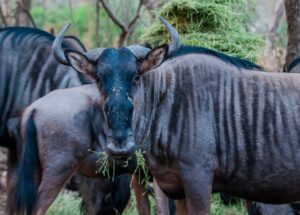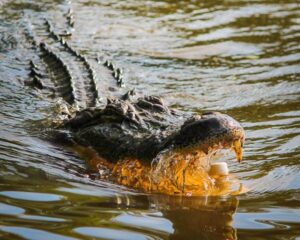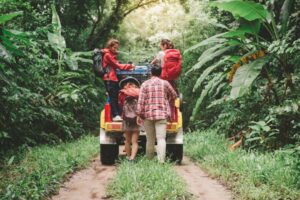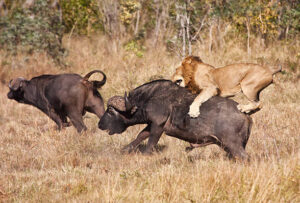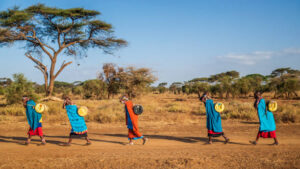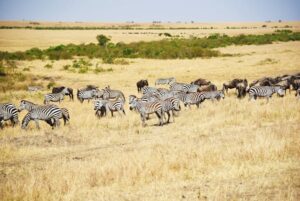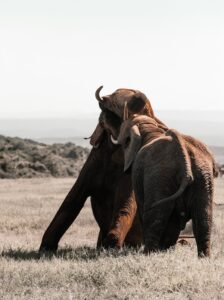The Great Migration in the Masai Mara is one of the most spectacular wildlife events on the planet. It involves the mass movement of over 1.5 million wildebeest, along with hundreds of thousands of zebras and gazelles, as they traverse the Serengeti-Mara ecosystem in search of fresh grazing. Understanding the timing, duration, and the intricacy of the Great Migration requires a detailed exploration.
Here is a comprehensive breakdown:
Overview of the Great Migration
Species Involved:
The migration primarily involves wildebeest, accompanied by zebras and Thomson’s gazelles. These species migrate in search of better grazing and water sources.
Geographical Range of Masai Mara:
The migration spans the Serengeti in Tanzania and the Masai Mara in Kenya, covering approximately 1,200 miles annually.
Duration of the Masai Mara Migration
The Great Migration is a year-long cycle, with different phases occurring at different times of the year. However, the portion that occurs within the Masai Mara generally spans from July to October. Here’s a detailed timeline:
January to March: Calving Season in the Southern Serengeti
Wildebeest calve in the short-grass plains of the southern Serengeti. Approximately 500,000 calves are born within a period of two to three weeks.
April to June: Movement Towards the Western Corridor of Masai Mara
As the rains end, the plains dry up, prompting the herds to move towards the western and central Serengeti. This period marks the start of the northward migration.
July to October: Crossing into the Masai Mara
The herds move towards the north, crossing the Grumeti River and then the Mara River into Kenya’s Masai Mara. This is the most dramatic and dangerous part of the migration due to predator encounters and river crossings. Peak viewing in the Masai Mara occurs from late July through October when the majority of the herds are present.
November to December: Returning to the Serengeti
The herds begin their southward journey back to the Serengeti as the short rains commence, leading them to the nutrient-rich southern plains for calving season again.
Phases of the Migration in the Masai Mara
River Crossings (July to August)
The crossings of the Mara River are one of the most anticipated events. These crossings are perilous, with crocodiles and strong currents posing significant threats to the animals.
Grazing in the Mara (August to September)
Once across the river, the herds spread out across the plains of the Masai Mara, feasting on the lush grasses. This is a period of relative peace and plenty.
Preparation for the Return (October)
As the dry season progresses, the animals start to gather and prepare for the return journey to the Serengeti. This period can still see some late crossings of the Mara River.
Factors Influencing the Migration Timing of Masai Mara
Rainfall Patterns:
The migration is heavily influenced by rainfall, which determines the availability of grazing and water. Variations in rainfall can shift the timing and routes taken by the herds.
Predator Presence:
Predators like lions, hyenas, and crocodiles impact the movement patterns. High predation pressure can alter the speed and direction of the herds.
Human Impact:
Human activities, including tourism and livestock grazing, can affect migration routes and timings. Conservation efforts are crucial to ensure the sustainability of this natural phenomenon.
Ecological Significance of the Migration
Grassland Health:
The migration helps maintain the health of the grassland ecosystems. The constant movement prevents overgrazing in one area and aids in nutrient cycling.
Predator-Prey Dynamics:
The migration supports a balanced predator-prey relationship. It ensures that predator populations remain healthy due to the availability of prey.
Biodiversity:
The migration supports a wide range of biodiversity, not just the migratory species but also the flora and fauna that depend on the changing dynamics of the ecosystem.
Conservation Efforts
Protected Areas:
Both the Serengeti and the Masai Mara are protected areas, and efforts are made to maintain the integrity of these ecosystems.
Community Involvement:
Engaging local communities in conservation through education and eco-tourism helps to reduce human-wildlife conflicts and promote sustainable practices.
Research and Monitoring:
Ongoing research and monitoring are essential to understand the migration patterns and address emerging threats. Satellite tracking and aerial surveys are commonly used methods.
Tourism and Its Impact
Economic Benefits:
The Great Migration attracts tourists from around the world, generating significant revenue that supports local economies and conservation initiatives.
Sustainable Practices:
Emphasizing sustainable tourism practices helps minimize environmental impact. This includes regulated safari tours and eco-friendly accommodations.
Experiencing the Migration
Best Viewing Times:
The best times to witness the migration in the Masai Mara are from late July to October. During this period, visitors can see the river crossings and large herds grazing on the plains.
Safari Options:
There are various safari options, including mobile camps, luxury lodges, and guided tours. Each offers unique experiences tailored to different preferences and budgets.
Photography and Filming:
The migration offers unparalleled opportunities for wildlife photography and filming. Patience and timing are crucial to capturing the most dramatic moments.
Future Prospects
Adaptive Management:
Ensuring the future of the Great Migration involves adaptive management strategies that can respond to changing environmental and socio-economic conditions.
International Cooperation:
Cross-border cooperation between Tanzania and Kenya is vital. Collaborative efforts ensure the migration route is protected across national boundaries.
Public Awareness:
Raising global awareness about the importance of the Great Migration and the threats it faces is crucial for garnering support for conservation efforts.
Conclusion
The Great Migration in the Masai Mara is a dynamic and complex natural event that showcases the incredible resilience and adaptability of wildlife. Understanding its duration, from July to October in the Masai Mara, involves appreciating the broader annual cycle that drives this movement. The migration is a testament to the interconnectedness of ecosystems and the critical need for concerted conservation efforts to preserve this natural wonder for future generations.
Make your Booking here to visit Masai mara.


